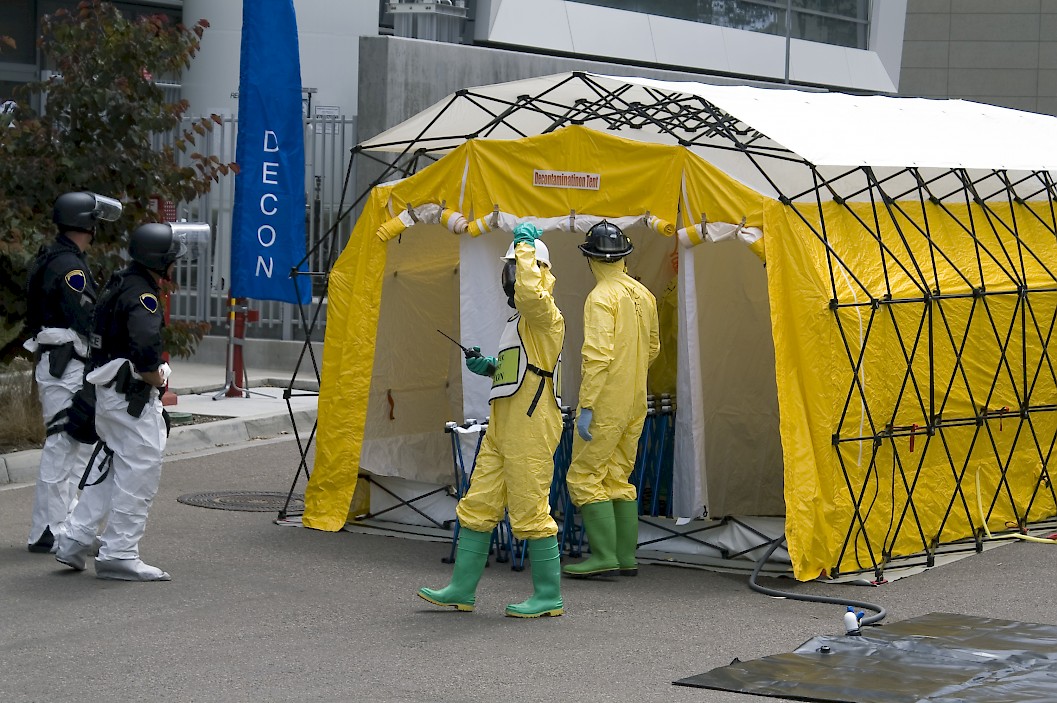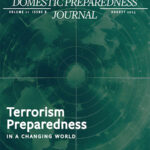Chemical, biological, radiological, and nuclear (CBRN) response has always been a challenge in identifying and quantifying a broad spectrum of organic and synthesized compounds that were once limited to laboratory analysis and research. Now, first responders have the luxury of instant field identification and classification of substances that were once a mystery. Previous field assays and test strips have been replaced by more advanced hand-held instrumentation and tools that are attached to a reach-back capacity with the power of remotely located science and research. However, one common gap remains. Comprehensive answers are still needed as to the proper decontamination of instruments and the people who use them.
When responding to CBRN calls or events, the operational layout and setup for most civilian and military entry teams are similar. Upon arrival at the scene, establish command and control, situational awareness, and personnel or robot deployment to identify and quantify the problem. Following best practices when working at or near a hazardous materials (hazmat) environment, the CBRN setup and entry process can be mustered and established in about an hour. However, what happens after that first entry is the most critical part of the response process – keeping the bad stuff contained. The entry team must understand what to do if it finds that the containment has breached into the community.
More Than Wet and Dry Decontamination
Decontamination practices, products, and techniques have come a long way. Recent advancements in technology and science have led to the development of new methods of CBRN decontamination. These methods offer several advantages over traditional methods, including greater speed, efficiency, and safety. Some of these new methods include:
Electrochemical Decontamination – This method uses electric current and a specially designed electrode to generate a reactive species that breaks down and neutralizes hazardous materials on contact. The process is highly effective in removing chemical contaminants. In addition, this method can be applied to surfaces and equipment of various shapes and sizes, making it an ideal choice for large-scale projects.
Photocatalytic Decontamination – This method uses light energy and a photocatalyst such as titanium dioxide that generates reactive species to break down and neutralize hazardous materials when activated by ultraviolet light. The process is highly effective in removing chemical and biological contaminants. This method is also more environmentally friendly, does not require harmful chemicals like bleach water, and can be applied to various surfaces, including concrete, metal, and glass.
Plasma Decontamination – This method uses a plasma generator to create plasma (a highly reactive gas) that breaks down and neutralizes hazardous materials on contact. This process is highly effective in removing biological and chemical contaminants. This method is also more environmentally friendly, does not require harmful chemicals, and can be applied to various surfaces, including metal, glass, and plastic.
Nanotechnology-Based Decontamination – This method uses nanoparticles that react with specific contaminants to break down and neutralize hazardous materials, which is highly effective for removing chemical and biological pollutants. Much faster than traditional chemical decontamination, this method can be applied to various surfaces, including concrete, metal, and glass.
Decontamination Teams at the Ready
There is no doubt that decontamination capabilities have advanced. So have detection and identification instruments and the abilities of hazmat entry teams, but the capacity of decontamination and deployment strategies have not kept pace. Currently, it is unknown exactly how many hazmat teams there are in the United States. What is known, is that hazmat response programs vary in size and capabilities depending on location and need. However, the National Fire Protection Association estimates that the United States has almost 30,000 fire departments, and most of those have some hazmat response capability. Some of those were once heavily supported with federal homeland security grants following the events of 2001. Many of those now compete for grant funding that is fractions of what was once available.
Local hospitals, once funded with Public Health Emergency Preparedness dollars and outfitted with CBRN decontamination tools, now appear to be compartmentalized, trailered, or warehoused without use. As a result, hospital decontamination teams are often a notation in a Joint Commission or policy binder in the charge nurse’s office. While there was a significant boost of funding during the COVID-19 pandemic, current detached, stagnant, and often disjointed approaches demonstrate the overarching issue. Dependence on the Strategic National Stockpile, designed to fill the gap in such events, appeared to be lackluster and, in most cases, dysfunctional.
Notwithstanding funding and supply chain issues, local hospitals, fire departments, and EMS agencies are destined to fight in the same way they train. Much like the military, training is typically designed around previous experience. Unfortunately, such an approach could be harmful to the responder should they encounter a chemical or radiological event while wearing the wrong personal protective equipment.
The United States Environmental Protection Agency also has a National Response Team comprising representatives from 15 federal agencies, including the Department of Homeland Security–FEMA, the Department of Defense, and the Department of Transportation. The National Response Team is responsible for coordinating federal response efforts for hazmat incidents. Unfortunately, access to these teams at the local level has its own potential challenges. Depending on the locale, requests for assistance can be delayed due to processing delays through the regional and state channels. Additionally, issues regarding the federalization of the event versus local control may impact the response.
The U.S. Department of Defense has its hazmat response teams, such as the Army Technical Escort Unit and the Navy’s Mobile Environmental Team, specifically trained to respond to CBRN materials. However, access to these teams is highly regulated and situational based on location, area of responsibility, and location.
In addition to the larger federal agencies, there are currently 17 Chemical, Biological, Radiological, Nuclear, and Explosive Enhanced Response Force Package (CERFP) units in the United States, one for each of the 10 FEMA regions, as well as the District of Columbia, Puerto Rico, Guam, and the U.S. Virgin Islands. Each CERFP comprises National Guard personnel from the Army and Air National Guard, who are specially trained and equipped to provide immediate assistance and support to local authorities during a CBRN incident. The CERFPs are part of the more extensive Defense Support of Civil Authorities mission. They deploy to an incident site to rapidly assess the situation, provide medical treatment and decontamination, and extract and evacuate casualties to a medical treatment facility. The response time is about 24 hours from deployment to full operational status.
Unfortunately, CBRN incidents typically occur without warning, and the exposure to the public can be exacerbated with every minute. Radiation exposure, for example, can be intensified up to four times its destructive energy with every step a responder or victim takes toward the often-invisible source. Local emergency responders are the first to arrive and mitigate these often-unseen hazards, but with diminishing funding opportunities, maintaining capacity is a challenge. However, local communities can still prepare for emergencies and disasters using an all-hazards approach.
Bridging the Gap
Before a structured activation, state and federal partners have several opportunities available to meet the challenge, which include but are not limited to the following:
State Emergency Management Offices can usually provide access to free hazmat/WMD training that is often available at the state and national level, including hazmat technician level training in accordance with National Fire Protection Association and ProBoard Standards.
The National Association of State Fire Marshals offers a Hazardous Materials Training Program, which provides training courses for emergency responders on various hazmat topics.
The National Fire Academy offers free online courses on hazmat response through their online learning platform at the Emergency Management Institute.
The Federal Emergency Management Agency (FEMA) offers various free online courses on hazmat response through their Emergency Management Institute.
The International Association of Fire Fighters offers training programs for its members on various hazmat response topics, including hazmat technician training.
The International Association of Fire Chiefs provides access to a wide array of international resources for responders in the transportation and industry sector.
The National Directorate Preparedness Consortium is sponsored by the Department of Homeland Security/FEMA National Preparedness Directorate to identify, develop, test, and deliver training to state and local emergency responders.
Conclusion
Overall, while federal funding has diminished, some national programs are still available to fill gaps. Since all disasters begin and end locally, it is vital that local responders meet CBRN challenges by accessing these programs. It is through these training opportunities and experiences that techniques and technology like decontamination and instrumentation can continue to grow. While some federal assets exist to supplement local capabilities with CBRN events, program access, and interface could be delayed for effective response. It is vital that local communities examine their capabilities and capacity to prepare for the unexpected.

Kenneth Bell
Kenneth Bell, CEM, serves as the Section Chief–Infrastructure and is a member of the Incident Response Task Force at the Texas Division of Emergency Management, where he oversees daily operations in preparation of disaster response and focuses on damage assessments and identification of impaired infrastructure with the goal of long-term restoration and recovery. He began his career in public safety in 1991, where he served as fire marshal/deputy emergency management coordinator for the City of San Marcos. From 2003 to 2016, Ken oversaw the Capital Area Council of Governments CBRNE Regional Response teams as the team commander for Hays County. He has served in several organizations, including the Capital Area Council of Government Homeland Security Task Force (since 2003), where he has held the position of chair, vice chair, and regional emergency response coordinator and was a member of the CBRNE Regional Response Teams, Long-Term Interoperable Communications Committee, Regional Emergency Support Education Teams (RESET), and Executive Committee. He has also served on the legislatively mandated Governors First Responder Advisory Committee, representing the local public safety responders, since its inception in 2003. Ken specializes in infrastructure protection, continuity of operations, and critical facility reconstitution. In addition, he is certified in fire, emergency medical services, and law enforcement, holding international qualifications as a health and safety officer.
- Kenneth Bellhttps://www.domesticpreparedness.com/author/kenneth-bell





